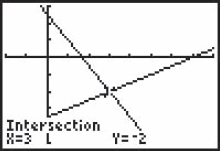9.3. Other Systems of Equations
9.3.1. A System with Fractional Coefficients
When an equation in our system has fractional coefficients, simply multiply that entire equation by some number that is divisible by each of the denominators in the equation. Such a number is called a common denominator. The smallest such number is called a least common denominator (LCD).
Example 20:Solve for x and y: 
Solution: We "clear" denominators by multiplying Eq. 1 by 6 and Eq. 2 by 4. 
Having x, we can now substitute back to get y. It is not necessary to substitute back into one of the original equations. We choose instead the easiest place to substitute, such as Eq. 4. (However, when checking, be sure to substitute your answers into both of the original equations.) Substituting x = 3 into Eq. 4 gives
|

TI-83/84 screen for Example 20.
9.3.2. Fractional Equations with Unknowns in the Denominator
The same method (multiplying by a common denominator) can be used to clear fractions when the unknowns appear in the denominators. Note that such equations are not linear (that is, not of first degree) ...
Get Technical Mathematics, Sixth Edition now with the O’Reilly learning platform.
O’Reilly members experience books, live events, courses curated by job role, and more from O’Reilly and nearly 200 top publishers.


